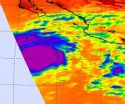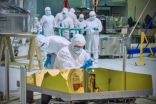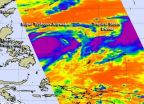(Press-News.org) Malignant cells that leave a primary tumor, travel the bloodstream and grow out of control in new locations cause the vast majority of cancer deaths. New nanotechnology developed at Case Western Reserve University detects these metastases in mouse models of breast cancer far earlier than current methods, a step toward earlier, life-saving diagnosis and treatment.
A team of scientists, engineers and students across five disciplines built nanochains that home in on metastases before they've grown into new tissues, and, through magnetic resonance imaging, detect their locations.
Images of the precise location and extent of metastases could be used to guide surgery or ablation, or the same technology used to find the cancer could be used to deliver cancer-killing drugs directly to the cells before a tumor forms, the researchers suggest.
The work is described in this week's online issue of the American Chemical Society journal ACS Nano.
"Micrometastases can't be seen with the naked eye, but you have to catch them at this stage – see the exact spots they're located and see them all," said Efstathios Karathanasis, assistant professor of biomedical engineering and radiology, and senior author. "Even if you miss only one, you prolong survival, but one metastasis can still kill."
Karathanasis worked with research associate Pubudu M. Peiris, graduate student Randall Toy; undergraduate students Elizabeth Doolittle, Jenna Pansky, Aaron Abramowski, Morgan Tam, Peter Vicente, Emily Tran, Elliott Hayden and Andrew Camann; medical student Zachary Berman, senior research associate Bernadette O. Erokwu, biomedical engineering professor David Wilson, chemical engineering associate professor Harihara Baskaran; and, from the Case Western Reserve School of Medicine, radiology assistant professor Chris A. Flask and pharmacology associate professor and department vice chair Ruth A. Keri.
Tumor detection technologies fail to uncover cancer cells that have taken hold in new locations because young metastases don't behave the same as established tumors.
After a breast cancer cell enters the bloodstream, it most often stops in the liver, spleen or lungs and begins overexpressing surface molecules called integrins. Integrins act as a glue between the cancer cell and the lining of a blood vessel that feeds the organ.
"We target integrins," Karathanasis said. "Normal blood vessel walls don't present integrins towards the blood site unless cancer cells attach there."
To home in on the cancer marker, the researchers first needed to build a nano device that would drift out of the central flow of the blood stream and to the blood vessel walls. The most common shape of nanoparticles is a sphere, but a sphere tends to go with the flow.
Karathanasis' team tailored nanoparticles to connect one to another much like a stack of Legos. Due to its size and shape, the oblong chain tumbles out of the main current and skirts along vessel walls.
The exterior of the chain has multiple sites designed to bind with integrins. Once one site latches on, others grab hold. Compared to nanospheres, the chains' attachment rate in flow tests was nearly 10-fold higher.
To enable a doctor to see where a relative few cancer cells sit in a sea of healthy cells, the scientists incorporated fluorescent markers and, to make the nanochains more visible in magnetic resonance imaging, four links made of iron oxide.
Next, the team tested the chains in a mouse model of an aggressive form of breast cancer that metastasizes to sites and organs much the same way it does in humans.
From established research, they knew metastases would be present five weeks into the modeling. They injected nanochains into the bloodstream and, within an hour, two imaging techniques - fluorescence molecular tomography and MRI's - showed where traveling cancer cells had established footholds, primarily in the liver, lungs and spleen.
The metastases located using the nanochains ranged from .2 to 2 millimeters across.
Later imaging at high magnification showed that these metastatic cancer cells were found mostly in the blood vessel walls, before they'd had time to grow into organ tissue.
"Once metastatic cells move into the tissue, develop their own microenvironment, and grow into a 1-centimeter lesion, it typically indicates a late stage of metastatic disease which has an unfavorable outcome," Karathanasis said.
According to the American Cancer Society, the 5-year survival rate of breast cancer patients sharply decreases from 98 percent in cases that catch the disease when it has produced only a localized primary lesion to 23 percent in cases in which distant large metastases have grown.
Now that they've proved the concept works, the team is bringing clinical radiologists on board led by Vikas Gulani, assistant professor of radiology. Their job is to help with a new study, calculating how much new cancer the technology finds and misses.
### END
Exposing cancer's lethal couriers
Nanochains mark micrometastases for early diagnosis, treatment
2012-09-25
ELSE PRESS RELEASES FROM THIS DATE:
White matter, old dogs, and new tricks at Dartmouth
2012-09-25
Most people equate "gray matter" with the brain and its higher functions, such as sensation and perception, but this is only one part of the anatomical puzzle inside our heads. Another cerebral component is the white matter, which makes up about half the brain by volume and serves as the communications network.
The gray matter, with its densely packed nerve cell bodies, does the thinking, the computing, the decision-making. But projecting from these cell bodies are the axons—the network cables. They constitute the white matter. Its color derives from myelin--a fat that ...
Bone marrow holds secrets for treating colitis and Crohn's
2012-09-25
EAST LANSING, Mich. — Michigan State University researchers have unlocked secrets in bone marrow that could lead to improved treatments for colitis and Crohn's disease.
The results, featured in the current issue of Proceedings of the National Academy of the Sciences, show that the havoc inflammatory bowel diseases wreaks on the digestive tract is mirrored in bone marrow. Early indications also show that the disorders of the gut could potentially be treated through the bone marrow, said Pam Fraker, MSU University Distinguished Professor of biochemistry and molecular biology.
"It's ...
MRI helps identify patients with prostate cancer who may benefit from active surveillance
2012-09-25
Philadelphia, PA, September 24, 2012 – PSA screening has resulted in improved prostate cancer survival, but the high rate of diagnosis and treatment side effects raise concerns about overtreatment. In the quest to prevent overtreatment, "active surveillance" has emerged as a plausible option, encouraged for men whose tumors may not need immediate treatment and may never progress to more serious illness. Appropriate criteria for selecting patients for active surveillance are continuously debated. A group of investigators from Memorial Sloan-Kettering Cancer Center in ...
Feeling guilty versus feeling angry -- who can tell the difference?
2012-09-25
When you rear-end the car in front of you at a stoplight, you may feel a mix of different emotions such as anger, anxiety, and guilt. The person whose car you rear-ended may feel angered and frustrated by your carelessness, but it's unlikely that he'll feel much guilt.
The ability to identify and distinguish between negative emotions helps us address the problem that led to those emotions in the first place. But while some people can tell the difference between feeling angry and guilty, others may not be able to separate the two. Distinguishing between anger and frustration ...
Yale researchers call for specialty metals recycling
2012-09-25
New Haven, Conn. -- An international policy is needed for recycling scarce specialty metals that are critical in the production of consumer goods, according to Yale researchers in Science.
"A recycling rate of zero for specialty metals is alarming when we consider that their use is growing quickly," said co-author Barbara Reck, a research scientist at the Yale School of Forestry & Environmental Studies.
Specialty metals, which include rare earth elements such as indium, gallium and germanium, account for more than 30 of the 60 metals in the periodic table. Because ...
NASA's satellite saw 'power-trigger' around Hurricane Miriam's center
2012-09-25
ASA's Aqua satellite revealed a large area of powerful thunderstorms around the center of Tropical Storm Miriam on Sept. 23 as it tracked through the Eastern Pacific Ocean. That power was the trigger that helped Miriam rapidly intensify into a major hurricane on Sept. 24.
NASA's Aqua satellite passed over the eastern Pacific Ocean on Sept. 23 and the Atmospheric Infrared Sounder (AIRS) instrument captured an infrared image of Tropical Storm Miriam's cloud top temperatures. Tropical Storm Miriam is born that day, about 640 miles (1,025 km) south-southeast of the southern ...
NASA's Global Hawk and satellites see tropical storm Nadine turning around
2012-09-25
Tropical Storm Nadine is turning around in two ways. When NASA's Global Hawk flew over the storm it learned that the storm was not transitioning into an extra-tropical storm. Now, NASA satellites see that Nadine is physically turning its direction, and heading back to the west-northwest and away from land.
The fifth science flight of NASA's Global Hawk concluded when the aircraft landed at NASA's Wallops Flight Facility, Wallops Island, Va. on Sunday, Sept. 23 after flying over Tropical Storm Nadine in the Eastern Atlantic Ocean. The Hurricane and Severe Storms Sentinel ...
First 2 Webb Telescope flight mirrors delivered to NASA
2012-09-25
The first two of the 18 primary mirrors to fly aboard NASA's James Webb Space Telescope arrived at NASA's Goddard Space Flight Center in Greenbelt, Md.
The mirrors are going through receiving and inspection and will then be stored in the Goddard cleanroom until engineers are ready to assemble them onto the telescope's backplane structure that will support them.
Ball Aerospace, Boulder, Colo., under contract to Northrop Grumman, is responsible for the Webb's optical technology and lightweight mirror system. On September 17, 2012, Ball Aerospace shipped the first two ...
Frigid cloudtop temperatures indicate strength in Super Typhoon Jelawat and Tropical Storm Ewinar
2012-09-25
Tropical Storm Jelawat had been moving toward the Philippines since the week of Sept. 17 and on Sept. 24 it became a super typhoon east of the country. Meanwhile, the nineteenth tropical depression formed just east of Jelawat in the western North Pacific Ocean and quickly strengthened into a tropical storm. Both storms were captured on one infrared image from NASA's Aqua satellite.
The Atmospheric Infrared Sounder (AIRS) instrument aboard NASA's Aqua satellite revealed a large area of powerful thunderstorms around the center of Typhoon Jelawat and a band of thunderstorms ...
Going viral to kill zits
2012-09-25
Watch out, acne. Doctors soon may have a new weapon against zits: a harmless virus living on our skin that naturally seeks out and kills the bacteria that cause pimples.
The Sept. 25 online edition of the American Society for Microbiology's mBio publishes the findings by scientists at UCLA and the University of Pittsburgh.
"Acne affects millions of people, yet we have few treatments that are both safe and effective," said principal investigator Dr. Robert Modlin, chief of dermatology and professor of microbiology, immunology and molecular genetics at the David Geffen ...
LAST 30 PRESS RELEASES:
First Editorial of 2026: Resisting AI slop
Joint ground- and space-based observations reveal Saturn-mass rogue planet
Inheritable genetic variant offers protection against blood cancer risk and progression
Pigs settled Pacific islands alongside early human voyagers
A Coral reef’s daily pulse reshapes microbes in surrounding waters
EAST Tokamak experiments exceed plasma density limit, offering new approach to fusion ignition
Groundbreaking discovery reveals Africa’s oldest cremation pyre and complex ritual practices
First breathing ‘lung-on-chip’ developed using genetically identical cells
How people moved pigs across the Pacific
Interaction of climate change and human activity and its impact on plant diversity in Qinghai-Tibet plateau
From addressing uncertainty to national strategy: an interpretation of Professor Lim Siong Guan’s views
Clinical trials on AI language model use in digestive healthcare
Scientists improve robotic visual–inertial trajectory localization accuracy using cross-modal interaction and selection techniques
Correlation between cancer cachexia and immune-related adverse events in HCC
Human adipose tissue: a new source for functional organoids
Metro lines double as freight highways during off-peak hours, Beijing study shows
Biomedical functions and applications of nanomaterials in tumor diagnosis and treatment: perspectives from ophthalmic oncology
3D imaging unveils how passivation improves perovskite solar cell performance
Enriching framework Al sites in 8-membered rings of Cu-SSZ-39 zeolite to enhance low-temperature ammonia selective catalytic reduction performance
AI-powered RNA drug development: a new frontier in therapeutics
Decoupling the HOR enhancement on PtRu: Dynamically matching interfacial water to reaction coordinates
Sulfur isn’t poisonous when it synergistically acts with phosphine in olefins hydroformylation
URI researchers uncover molecular mechanisms behind speciation in corals
Chitin based carbon aerogel offers a cleaner way to store thermal energy
Tracing hidden sources of nitrate pollution in rapidly changing rural urban landscapes
Viruses on plastic pollution may quietly accelerate the spread of antibiotic resistance
Three UH Rainbow Babies & Children’s faculty elected to prestigious American Pediatric Society
Tunnel resilience models unveiled to aid post-earthquake recovery
Satellite communication systems: the future of 5G/6G connectivity
Space computing power networks: a new frontier for satellite technologies
[Press-News.org] Exposing cancer's lethal couriersNanochains mark micrometastases for early diagnosis, treatment





